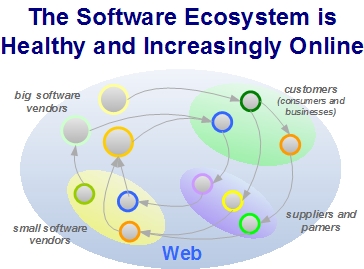Outlook on software in 2006: Healthy, disruptive

An increasing amount of attention is being given to the new Software 2006 Industry Report from the respected Mckinsey and Company (along with the Sandhill group). The report is a high level look at the overall state of the software industry and is chock full of interesting and informative tidbits. You can read it for yourself as they have kindly made it available online in PDF form. Some of information isn't too surprising, namely that we're just now fully recovering from Bubble 1.0 and that software is increasingly moving online.
Others are more bold and include the prediction that the adoption of Web 2.0 technologies in the enterprise actually represents a far larger market than the consumer space:
Web 2.0 for the Enterprise. As in previous innovation cycles, whenever multiple point capabilities converge – such as wireless, pervasive broadband, and online collaboration – many new applications become possible. In these cases, consumers tend to adopt the new services and products before the enterprise, but in the end the enterprise market is usually far larger and more profitable. We believe that much of the hype around “Web 2.0” for consumers – with its rapid innovation in content (e.g., blogs, wikis, user editing and tagging), tools like search, and services like content hosting –heralds a much larger opportunity to put these innovations to work in the enterprise.
Three broad themes emerge from the report in general. Interestingly, one is the concept of a software ecosystem, an interrelated set of software suppliers, partners, and customers. My premise for a while now is that we're seeing an actual software ecosystem forming on the Web. And when you add SaaS, mashups, composite apps, and the Salesforce/Amazon models, you get a living, vital ecosystem of information, services, and people. The report seems to affirm this view and goes on to state that this ecosystem is now relatively healthy for the first time in years and now has ready access to capital and increasing profitability.
Another theme in the report is the prediction that the last remaining bastion of untapped productivity lies in something called "tacit interactions". Mckinsey has been socializing the ideas behind this concept for a while now, and tacit interactions are essentially this:
[They] involve judgment or insight applied to complex communications or problem solving, and often occurs in, say, management, sales, customer service. Tacit interactions differ from transformational interactions (changing a physical good into something else) and transactional interactions (following set rules in a repeatable fashion). They now represent 41 percent of all U.S. worker activity (measured by number of jobs) and are growing the most rapidly. However, only 24 percent of software investments today support them.
This study claims that this is where Web 2.0 technologies will reshape the enterprise by supporting tacit interactions via software tools that collaboratively managing data, information, and people. The subsequent decision support, communications, and workflow enablement that becomes possible with the dynamic online tools available today will unleash new productivity and value. That's the premise anyway.
Finally, the report states that organizing for flexibility and encouraging innovation beyond technology are the two most important take aways from these trends. I do believe that organizational agility is increasingly becoming a competitive advantage and we are indeed seeing a surpisingly level of innovation in the industry, particularly around Web 2.0 experiences. Our new models for working online via social software are demonstrating what new innovations are possible.

ITNews also cites some good take aways from Merrill Lynch's view of this report:
Merrill Lynch said the implication is large enterprise software companies, such as SAP and Oracle, must begin to design applications as easy to use, such as Google and Salesforce.com, for the masses. They need to target enterprise applications toward the masses, companies that have higher thresholds "for usability and do not have the bandwidth to be trained like the core group of users of these applications."
In any case, the software industry does seem actively worried about excess valuation and other problems that happened the first time around. These seem to be largely addressed in this new wave, and we're witnessing the flourishing of a new age of software that is online, collaborative, innovative. I almost have a hard time accepting that the enterprise will be the biggest beneficiary of the current software boom. But until the monetization challenges with consumer Web 2.0 are resolved, they just might be right.
What do you think the biggest trend in software is today? Is it really Web 2.0 and SaaS?